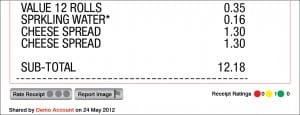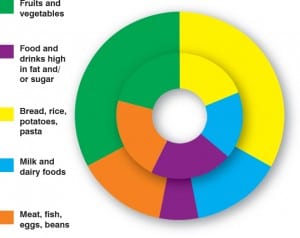We have recently published an article in the ACM Interactions magazine, which is the most widely read industry & research magazine in the field of Human Computer Interaction. The article reports work carried out in the 2011/2012 academic year by two undergraduate students in the Lincoln School of Computer Science. The students, Tom Leeman and Chris Borrowdale, worked on their final year projects under the supervision of Dr. Conor Linehan – building and evaluating social media systems with the intention of helping users monitor and control their diet. Quick descriptions of the two projects:
Social Receipt
Social Receipt aimed to provoke people to think more critically and make more informed decisions about food purchasing. It sought to provide feedback to users on the healthiness of their diet. A bespoke social networking system was developed that allowed for the uploading of photographs and text-based interaction between users. Food purchasing was measured through the participants’ uploading of shopping receipts to the website. Analysis of receipts was crowdsourced among users, and users rated receipts via the traffic-light system commonly seen on food packaging in the U.K. (see Figure 1). We were interested in whether we could derive valid health information from the uploaded receipts through crowdsourcing the analysis of those receipts among the users of the site. Dietary feedback was delivered to users numerically, through the crowdsourcing task, but also socially, through the interaction of participants using typical social-network commenting systems. A prototype of the application is available to access in a limited capacity at http://socialreceipt.tomleeman.co.uk
Plate and Rate
Plate and Rate aimed to provoke people to think more critically and make more informed decisions about food consumption. It also sought to facilitate an understanding of long-term dietary balance, something that people often find difficult. A Web-based application was developed, which, similar to Social Receipt, allowed for the uploading of photographs and text-based interaction between users. Food consumption was measured through the uploading of food photographs, and participants were expected to upload photographs of all their meals. Analysis of these photographs was carried out anonymously by other users of the application, who were asked to rate the plates of food uploaded in terms of how closely they resembled the Eatwell Plate, a visualization of a balanced diet developed by the U.K. National Health Service (see Figure 2). Ratings were averaged across users in order to generate a consensus rating for each plate. Feedback was presented to users via their own personal profiles, on which they could see a number of statistics showing how they differed from the guideline for each meal uploaded, as well as a visualization of the overall balance of their longer-term diet.
Full text of the article is available for free on the magazine website.

